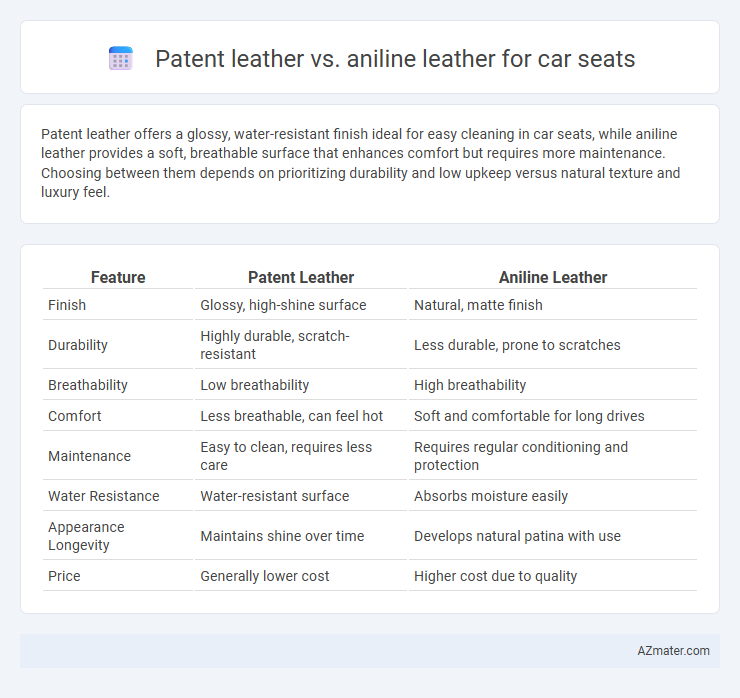Patent leather offers a glossy, water-resistant finish ideal for easy cleaning in car seats, while aniline leather provides a soft, breathable surface that enhances comfort but requires more maintenance. Choosing between them depends on prioritizing durability and low upkeep versus natural texture and luxury feel.
Table of Comparison
| Feature | Patent Leather | Aniline Leather |
|---|---|---|
| Finish | Glossy, high-shine surface | Natural, matte finish |
| Durability | Highly durable, scratch-resistant | Less durable, prone to scratches |
| Breathability | Low breathability | High breathability |
| Comfort | Less breathable, can feel hot | Soft and comfortable for long drives |
| Maintenance | Easy to clean, requires less care | Requires regular conditioning and protection |
| Water Resistance | Water-resistant surface | Absorbs moisture easily |
| Appearance Longevity | Maintains shine over time | Develops natural patina with use |
| Price | Generally lower cost | Higher cost due to quality |
Introduction to Patent Leather and Aniline Leather
Patent leather features a high-gloss finish created by coating natural leather with a lacquer or synthetic polymer, making it highly resistant to stains and easy to clean. Aniline leather, derived from full-grain hides, is dyed with soluble aniline dyes that preserve the natural texture and breathability but require careful maintenance to prevent staining. Both types offer distinct aesthetics and durability characteristics critical to automotive upholstery design.
Key Differences in Manufacturing Processes
Patent leather for car seats undergoes a coating process where a high-gloss finish is applied using synthetic polymers, creating a shiny, durable surface resistant to stains and moisture. Aniline leather, in contrast, is dyed with soluble dyes that penetrate deeply without surface coating, preserving the natural texture and breathability but resulting in a softer, more vulnerable finish. The manufacturing of patent leather involves additional steps like lacquering and curing, whereas aniline leather emphasizes minimal processing to maintain its natural characteristics.
Appearance and Aesthetic Qualities
Patent leather displays a glossy, mirror-like finish characterized by its highly reflective surface, making car seats visually striking and sleek. Aniline leather offers a natural, matte appearance with visible grain and subtle color variations that enhance the seat's richness and authenticity. While patent leather prioritizes a polished, modern aesthetic, aniline leather emphasizes warmth and organic texture, catering to different style preferences in automotive interiors.
Durability and Wear Resistance
Patent leather offers superior wear resistance for car seats due to its glossy, sealed surface that resists scratches and moisture, making it highly durable in everyday use. Aniline leather, while softer and more breathable, lacks a protective coating, which makes it more susceptible to fading, stains, and damage from abrasion over time. For longevity and consistent durability in automotive seating, patent leather is generally the preferred choice.
Comfort and Breathability Factors
Patent leather, with its glossy, coated surface, offers a sleek appearance but typically lacks breathability, often causing discomfort during long drives due to heat and moisture buildup. Aniline leather, treated with transparent dyes preserving the natural pores, provides superior breathability and softness, enhancing comfort by allowing air circulation and reducing perspiration. For car seats, aniline leather stands out as the preferred option when prioritizing comfort and breathability, especially in varying temperature conditions.
Maintenance Requirements and Care Tips
Patent leather car seats require minimal maintenance due to their glossy, non-porous surface that repels stains and dirt easily, needing only regular wiping with a damp cloth. Aniline leather, being more porous and natural, demands more frequent conditioning with pH-balanced leather care products to prevent drying and cracking, as well as gentle cleaning with mild leather cleaners to preserve its breathability and rich texture. Proper care of patent leather involves avoiding abrasive materials to maintain shine, whereas aniline leather benefits from protection against direct sunlight and spills to extend its lifespan and aesthetic appeal.
Stain Resistance and Cleaning Challenges
Patent leather offers superior stain resistance compared to aniline leather due to its glossy, sealed surface that repels liquids and dirt, making it easier to clean with simple wiping. Aniline leather, characterized by its natural and porous finish, is more prone to staining and requires specialized cleaning products and techniques to avoid damage. Stain removal on aniline leather demands cautious maintenance to preserve its softness and appearance, whereas patent leather requires minimal effort for upkeep.
Cost and Value Considerations
Patent leather, known for its glossy finish and durability, typically costs less than aniline leather, making it a budget-friendly option for car seats. Aniline leather, valued for its natural look and breathability, carries a higher price due to its premium quality and the minimal surface treatment it undergoes. Choosing aniline leather enhances vehicle luxury and resale value, while patent leather offers a cost-effective, low-maintenance alternative.
Environmental Impact and Sustainability
Patent leather, often coated with synthetic polymers, tends to have a higher environmental impact due to the use of non-biodegradable chemicals and intensive energy-consuming processes, making it less sustainable for car seats. Aniline leather, being minimally processed and dyed with soluble dyes, maintains more natural characteristics and generally has a lower environmental footprint, especially when sourced from tanneries employing eco-friendly practices. Choosing aniline leather for car seats promotes sustainability through biodegradability and reduced chemical usage, aligning better with environmentally conscious automotive manufacturing.
Which Leather is Best for Car Seats?
Aniline leather offers a natural, breathable, and soft texture, ideal for car seats requiring comfort and premium aesthetics, but it is more susceptible to stains and wear. Patent leather provides a glossy, durable, and water-resistant surface, making it easier to clean and maintain, though it lacks breathability and can cause discomfort in hot conditions. For car seats, aniline leather is best suited for luxury vehicles prioritizing comfort, while patent leather suits vehicles needing durability and easy maintenance.

Infographic: Patent leather vs Aniline leather for Car seat
 azmater.com
azmater.com